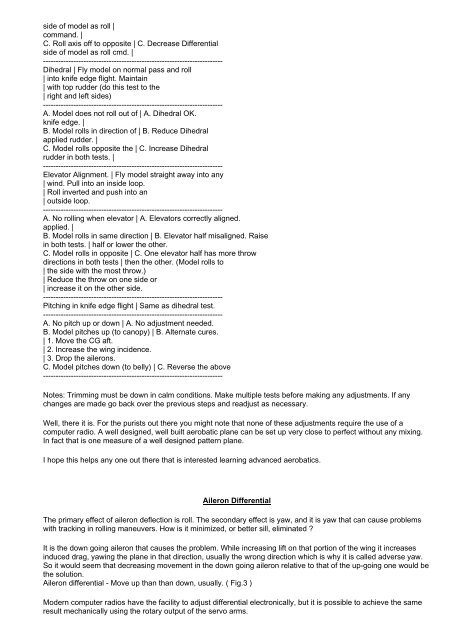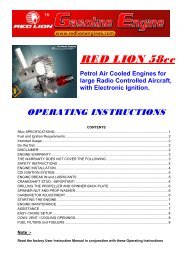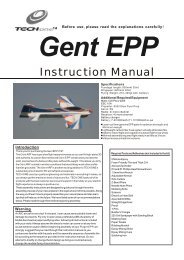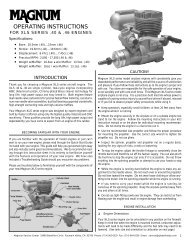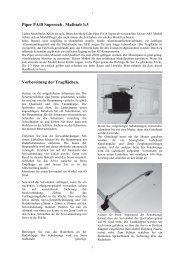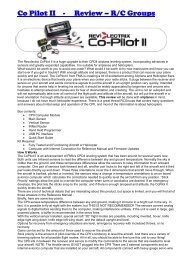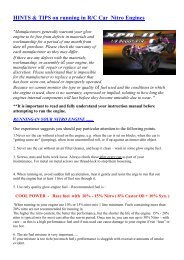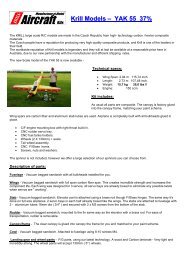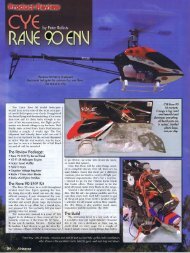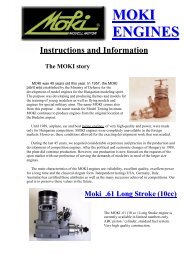You also want an ePaper? Increase the reach of your titles
YUMPU automatically turns print PDFs into web optimized ePapers that Google loves.
side <strong>of</strong> model as roll |command. |C. Roll axis <strong>of</strong>f to opposite | C. Decrease Differentialside <strong>of</strong> model as roll cmd. |-----------------------------------------------------------------------Dihedral | Fly model on normal pass and roll| into knife edge flight. Maintain| with top rudder (do this test to the| right and left sides)-----------------------------------------------------------------------A. Model does not roll out <strong>of</strong> | A. Dihedral OK.knife edge. |B. Model rolls in direction <strong>of</strong> | B. Reduce Dihedralapplied rudder. |C. Model rolls opposite the | C. Increase Dihedralrudder in both tests. |-----------------------------------------------------------------------Elevator Alignment. | Fly model straight away into any| wind. Pull into an inside loop.| Roll inverted and push into an| outside loop.-----------------------------------------------------------------------A. No rolling when elevator | A. Elevators correctly aligned.applied. |B. Model rolls in same direction | B. Elevator half misaligned. Raisein both tests. | half or lower the other.C. Model rolls in opposite | C. One elevator half has more throwdirections in both tests | then the other. (Model rolls to| the side with the most throw.)| Reduce the throw on one side or| increase it on the other side.-----------------------------------------------------------------------Pitching in knife edge flight | Same as dihedral test.-----------------------------------------------------------------------A. No pitch up or down | A. No adjustment needed.B. Model pitches up (to canopy) | B. Alternate cures.| 1. Move the CG aft.| 2. Increase the wing incidence.| 3. Drop the ailerons.C. Model pitches down (to belly) | C. Reverse the above-----------------------------------------------------------------------Notes: Trimming must be down in calm conditions. Make multiple tests before making any adjustments. If anychanges are made go back over the previous steps and readjust as necessary.Well, there it is. For the purists out there you might note that none <strong>of</strong> these adjustments require the use <strong>of</strong> acomputer radio. A well designed, well built aerobatic plane can be set up very close to perfect without any mixing.In fact that is one measure <strong>of</strong> a well designed pattern plane.I hope this helps any one out there that is interested learning advanced aerobatics.Aileron DifferentialThe primary effect <strong>of</strong> aileron deflection is roll. The secondary effect is yaw, and it is yaw that can cause problemswith tracking in rolling maneuvers. How is it minimized, or better sill, eliminated ?It is the down going aileron that causes the problem. While increasing lift on that portion <strong>of</strong> the wing it increasesinduced drag, yawing the plane in that direction, usually the wrong direction which is why it is called adverse yaw.So it would seem that decreasing movement in the down going aileron relative to that <strong>of</strong> the up-going one would bethe solution.Aileron differential - Move up than than down, usually. ( Fig.3 )Modern computer radios have the facility to adjust differential electronically, but it is possible to achieve the sameresult mechanically using the rotary output <strong>of</strong> the servo arms.


